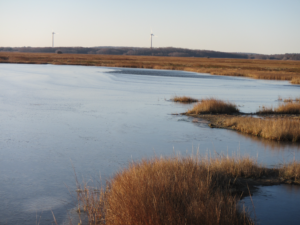How Will Marsh Hydrology…?
 Salt marshes support valuable ecosystem services and are critically important in maintaining the resiliency of coastal communities to storms and rising sea levels. Management decisions often involve tradeoffs; actions that optimize one ecosystem service may negatively affect another. One of the clearest examples of this balancing act are man-made ditches, most of which were dug in the 1920’s - 1940’s. The goals of parallel grid ditching, which impacted 90% of mid-Atlantic and New England salt marshes, were to provide employment opportunities during the Great Depression and control mosquito populations. This decision had unintended consequences for marsh sustainability and ecosystem service delivery, the net effects of which are still unclear.
Salt marshes support valuable ecosystem services and are critically important in maintaining the resiliency of coastal communities to storms and rising sea levels. Management decisions often involve tradeoffs; actions that optimize one ecosystem service may negatively affect another. One of the clearest examples of this balancing act are man-made ditches, most of which were dug in the 1920’s - 1940’s. The goals of parallel grid ditching, which impacted 90% of mid-Atlantic and New England salt marshes, were to provide employment opportunities during the Great Depression and control mosquito populations. This decision had unintended consequences for marsh sustainability and ecosystem service delivery, the net effects of which are still unclear.
Extensive grid-ditching can have the dual effects of reducing the density of shallow pools, where mosquitos breed, and increasing habitat availability for emergent grasses. Ditches increase water drainage efficiency from the marsh platform and, by intersecting pools, convert areas of standing water to bare peat. Emergent grasses can then colonize these bare spots and promote rapid rates of soil accretion. Consequently, former pools may eventually have the same plant communities and elevation as the surrounding marsh platform.
However, there is some evidence that efficient drainage may instead reduce marsh sustainability by changing both the biogeochemistry and the physical structure of the platform. Increasing drainage efficiency and lowering the water table likely affect belowground redox conditions and promote faster rates of aerobic respiration. This may literally undermine the marsh by accelerating rates of organic matter decomposition and lowering the marsh surface. In addition, increased drainage results in soil compaction due to water loss and pore space reduction (i.e., consolidation). In ditched marshes, it is likely that soil consolidation and organic matter degradation co-occur, and together cause shallow subsidence and loss of marsh elevation.
There are many tradeoffs in deciding how to manage marsh hydrology. Maintaining extensive ditch networks is expensive, reduces pool habitat for fishes and birds, and may lower the elevation of the marsh, making it less sustainable as sea level rises. Neglecting ditch maintenance may result in blockages that increase habitat availability for mosquitos but limit fish access to pools. Restoring ditches by purposely making them shallower, reshaping them, or filling them in may also affect marsh drainage efficiency and, likely, pool density, emergent grass productivity, and vertical accretion rates. Navigating these tradeoffs is further complicated by climate change impacts, such as sea level rise, and site-specific factors, such as tidal range. Our goal is to support end users in assessing the tradeoffs of hydrologic management strategies in salt marsh ecosystems by developing decision support tools through targeted science and a collaborative learning process.
